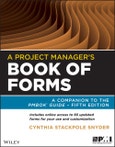A compendium of ready–made forms for managing every project in line with the latest PMBOK® Guide—Fifth Edition
This valuable companion to the Project Management Institute′s A Guide to the Project Management Body of Knowledge (PMBOK® Guide)—Fifth Edition presents a comprehensive and practical set of forms and reports that help project managers apply the concepts and practices described in the PMBOK® Guide.
Designed specifically to assist both new and experienced project managers in handling all aspects of a project, this edition of A Project Manager′s Book of Forms contains forms that cover all the process groups: initiating, planning, executing, monitoring and controlling, and closing. It also includes some forms not mentioned in the PMBOK® Guide, which you will find helpful in managing your project.
Use the forms as a guide in collecting and organizing project information, or as a template for ensuring a set of consistent data on all projects. The forms can also be adopted on an organizational level to enable a repeatable approach to project management.
Completely editable electronic versions of all the blank forms, in Microsoft Office–compatible format, are available on an accompanying website. You may use them as is or tailor them to your own needs.
The PMBOK® Guide covers the processes for managing a project; this book gives you a handy road map of forms to use to make every project just a bit smoother from start to finish.
(PMBOK is a registered marks of the Project Management Institute, Inc.)
Table of Contents
Acknowledgments vii
Introduction ix
1 Initiating Forms 1
1.0 Initiating Process Group 1
1.1 Project Charter 2
1.2 Stakeholder Register 8
1.3 Stakeholder Analysis Matrix 11
2 Planning Forms 13
2.0 Planning Process Group 13
2.1 Project Management Plan 16
2.2 Scope Management Plan 20
2.3 Requirements Management Plan 23
2.4 Requirements Documentation 27
2.5 Requirements Traceability Matrix 29
2.6 Project Scope Statement 33
2.7 Assumption and Constraint Log 36
2.8 Work Breakdown Structure 38
2.9 WBS Dictionary 40
2.10 Schedule Management Plan 43
2.11 Activity List 46
2.12 Activity Attributes 48
2.13 Milestone List 51
2.14 Network Diagram 53
2.15 Activity Resource Requirements 55
2.16 Resource Breakdown Structure 57
2.17 Activity Duration Estimates 59
2.18 Duration Estimating Worksheet 61
2.19 Project Schedule 65
2.20 Cost Management Plan 68
2.21 Activity Cost Estimates 71
2.22 Cost Estimating Worksheet 73
2.23 Cost Baseline 78
2.24 Quality Management Plan 80
2.25 Quality Metrics 83
2.26 Process Improvement Plan 85
2.27 Responsibility Assignment Matrix 91
2.28 Roles and Responsibilities 93
2.29 Human Resource Management Plan 96
2.30 Communications Management Plan 100
2.31 Risk Management Plan 102
2.32 Risk Register 109
2.33 Probability and Impact Assessment 112
2.34 Probability and Impact Matrix 117
2.35 Risk Data Sheet 119
2.36 Procurement Management Plan 122
2.37 Source Selection Criteria 127
2.38 Stakeholder Management Plan 129
2.39 Change Management Plan 132
3 Executing Forms 135
3.0 Executing Process Group 135
3.1 Team Member Status Report 137
3.2 Change Request 143
3.3 Change Log 148
3.4 Decision Log 150
3.5 Quality Audit 152
3.6 Team Directory 155
3.7 Team Operating Agreement 157
3.8 Team Performance Assessment 160
3.9 Team Member Performance Assessment 165
3.10 Issue Log 170
4 Monitoring and Control Forms 173
4.0 Monitoring and Controlling Process Group 173
4.1 Project Performance Report 175
4.2 Variance Analysis 181
4.3 Earned Value Status 185
4.4 Risk Audit 188
4.5 Contractor Status Report 192
4.6 Formal Acceptance 196
5 Closing 199
5.0 Closing Process Group 199
5.1 Procurement Audit 199
5.2 Contract Close–Out 203
5.3 Project or Phase Close–Out 207
5.4 Lessons Learned 211
Authors
CYNTHIA STACKPOLE SNYDER, PMP, EVP, MBA, is a well–known project management consultant and was the project manager for the team that updated PMI′s Project Management Body of KnowledgeFourth Edition. She is also the author of A User′s Manual to the PMBOK® Guide, now in its second edition.








